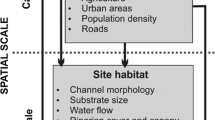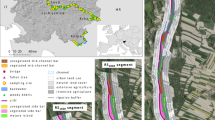Abstract
This study compares the relative influences of physiography and anthropogenic pressures on river biota at catchment, riparian corridor, and reach scales. Environmental data, catchment and riparian corridor land use, anthropogenic modifications and biological data were compiled for 301 French sites sampled from 2005 to 2008. First, relationships between anthropogenic pressures and fish and macroinvertebrate assemblages were analysed using redundancy analysis. Second, the influences of physiography and the three scales of human pressures on biological assemblages were measured using variance partitioning. Distributions of fish and macroinvertebrate taxa along the pressure gradients agreed with bio-ecological knowledge. At the reach scale, assemblage variability among the 301 French sites was related to the presence of an impoundment and to poor water quality, while at larger scales it was linked to a gradient from forest to agricultural covers. In addition, a large proportion of the explained variability in assemblage composition was related to complex interactions among factors (~40%) and to physiographic variables (~30%). Furthermore, our results highlight that catchment land use better reflects local water quality impairments than hydromorphological degradations. Finally, this study supports the idea that human pressure effects on river communities are linked at several spatial scales and must be considered jointly.





Similar content being viewed by others
References
AFNOR, 2004a. Qualité de l’eau—Détermination de l’indice poissons rivières (IPR). Association française de normalisation. Norme homologuée T90-344.
AFNOR, 2004b. Qualité écologique des milieux aquatiques. Qualité de l’eau—Détermination de l’indice biologique global normalisé (IBGN). Association française de normalisation. Norme homologuée T90-350.
Allan, J. D., 2004. Influence of land use and landscape setting on the ecological status of rivers. Limnetica 23: 187–198.
Allan, J. D. & A. S. Flecker, 1993. Biodiversity conservation in running waters. BioScience 43: 32–43.
Allan, J. D., D. L. Erickson & J. Fay, 1997. The influence of catchment land use on stream integrity across multiple spatial scales. Freshwater Biology 37: 149–161.
Angermeier, P. L. & M. R. Winston, 1998. Local vs. regional influences on local diversity in stream fish communities of Virginia. Ecology 79: 911–927.
Argent, D. G. & R. F. Carline, 2004. Fish assemblage changes in relation to watershed landuse disturbance. Aquatic Ecosystem Health and Management 7: 101–114.
Baxter, R. M., 1977. Environmental effects of dams and impoundments. Annual Review of Ecology and Systematics 8: 255–283.
Bedoya, D., E. S. Manolakos & V. Novotny, 2011. Characterization of biological responses under different environmental conditions: a hierarchical modeling approach. Ecological Modelling 222: 532–545.
Bis, B., A. Zdanowicz & M. Zalewski, 2000. Effects of catchment properties on hydrochemistry, habitat complexity and invertebrate community structure in a lowland river. Hydrobiologia 422–423: 369–387.
Borcard, D., F. Gillet & P. Legendre, 2011. Numerical Ecology with R. Use R! Series. Springer, New York.
Brazner, J. C., D. K. Tanner, N. E. Detenbeck, S. L. Batterman, S. L. Stark, L. A. Jagger & V. M. Snarski, 2005. Regional, watershed, and site-specific environmental influences on fish assemblage structure and function in western Lake Superior tributaries. Canadian Journal of Fisheries and Aquatic Sciences 62: 1254–1270.
Buck, O., D. K. Niyogi & C. R. Townsend, 2004. Scale-dependence of land use effects on water quality of streams in agricultural catchments. Environmental Pollution 130: 287–299.
Durance, I., C. Lepichon & S. J. Ormerod, 2006. Recognizing the importance of scale in the ecology and management of riverine fish. River Research and Applications 22: 1143–1152.
Esselman, P. C. & J. D. Allan, 2010. Relative influences of catchment- and reach-scale abiotic factors on freshwater fish communities in rivers of northeastern Mesoamerica. Ecology of Freshwater Fish 19: 439–454.
European Union, 2000. Directive 2000/60/EC. Establishing a Framework for Community Action in the Field of Water Policy. European Commission PE-CONS 3639/1/100 Rev 1, Luxemburg.
Fausch, K. D., C. E. Torgersen, C. V. Baxter & H. W. Li, 2002. Landscapes to riverscapes: bridging the gap between research and conservation of stream fishes. Bioscience 52: 483–498.
Flinders, C. A., R. J. Horwitz & T. Belton, 2008. Relationship of fish and macroinvertebrate communities in the mid-Atlantic uplands: implications for integrated assessments. Ecological Indicators 8: 588–598.
Frissell, C. A., W. J. Liss, C. E. Warren & M. D. Hurley, 1986. A hierarchical framework for stream habitat classification—viewing streams in a watershed context. Environmental Management 10: 199–214.
Hering, D., R. K. Johnson, S. Kramm, S. Schmutz, K. Szoszkiewicz & P. F. M. Verdonschot, 2006. Assessment of European streams with diatoms, macrophytes, macroinvertebrates and fish: a comparative metric-based analysis of organism response to stress. Freshwater Biology 51: 1757–1785.
Hill, M. O. & A. J. E. Smith, 1976. Principal component analysis of taxonomic data with multi-state discrete characters. Taxon 25: 249–255.
Hrodey, P. J., T. M. Sutton, E. A. Frimpong & T. P. Simon, 2009. Land-use impacts on watershed health and integrity in Indiana warmwater streams. American Midland Naturalist 161: 76–95.
Johnson, R. K., D. Hering, M. T. Furse & R. T. Clarke, 2006. Detection of ecological change using multiple organism groups: metrics and uncertainty. Hydrobiologia 566: 115–137.
Johnson, R. K., M. T. Furse, D. Hering & L. Sandin, 2007. Ecological relationships between stream communities and spatial scale: implications for designing catchment-level monitoring programmes. Freshwater Biology 52: 939–958.
Justus, B. G., J. C. Petersen, S. R. Femmer, J. V. Davis & J. E. Wallace, 2010. A comparison of algal, macroinvertebrate, and fish assemblage indices for assessing low-level nutrient enrichment in wadeable Ozark streams. Ecological Indicators 10: 627–638.
Kottelat, M. & J. Freyhof, 2007. Handbook of European Freshwater Fishes. Kottelat, Cornol.
Kroll, S. A., C. N. Llacer, M. De La Cruz Cano & J. De Las Heras, 2009. The influence of land use on water quality and macroinvertebrate biotic indices in rivers within Castilla-La Mancha (Spain). Limnetica 28: 203–214.
Lafont, M., J. C. Camus & A. Rosso, 1996. Superficial and hyporheic oligochaete communities as indicators of pollution and water exchange in the River Moselle, France. Hydrobiologia 334: 147–155.
Lammert, M. & J. D. Allan, 1999. Assessing biotic integrity of streams: effects of scale in measuring the influence of land use/cover and habitat structure on fish and macroinvertebrates. Environmental Management 23: 257–270.
Linnæus, C., 1758. Systema naturæ per regna tria naturæ, secundum classes, ordines, genera, species, cum characteribus, differentiis, synonymis, locis. Tomus I. Editio decima, reformata.
Logez, M., D. Pont & M. T. Ferreira, 2010. Do Iberian and European fish faunas exhibit convergent functional structure along environmental gradients? Journal of the North American Benthological Society 29: 1310–1323.
Marzin, A., V. Archaimbault, J. Belliard, C. Chauvin, F. Delmas & D. Pont, 2012. Ecological assessment of running waters: do macrophytes, macroinvertebrates, diatoms and fish show similar responses to human pressures? Ecological Indicators 23: 56–65.
Moerke, A. H. & G. A. Lamberti, 2006. Scale-dependent influences on water quality, habitat, and fish communities in streams of the Kalamazoo River Basin, Michigan (USA). Aquatic Sciences 68: 193–205.
Naiman, R. J., 1992. New perspectives for watershed management: balancing long-term sustainability with cumulative environmental change. In Naiman, R. J. (ed.), Watershed Management: Balancing Sustainability and Environmental Change. Springer, NewYork.
Nerbonne, B. A. & B. Vondracek, 2001. Effects of local land use on physical habitat, benthic macroinvertebrates, and fish in the Whitewater River, Minnesota, USA. Environmental Management 28: 87–99.
Peres-Neto, P. R., P. Legendre, S. Dray & D. Borcard, 2006. Variation partitioning of species data matrices: estimation and comparison of fractions. Ecology 87: 2614–2625.
Pinto, B. C. T., F. G. Araujo & R. M. Hughes, 2006. Effects of landscape and riparian condition on a fish index of biotic integrity in a large southeastern Brazil river. Hydrobiologia 556: 69–83.
Poff, N. L., 1997. Landscape filters and species traits: towards mechanistic understanding and prediction in stream ecology. Journal of the North American Benthological Society 16: 391–409.
Rice, W. R., 1989. Analyzing tables of statistical tests. Evolution 43: 223–225.
Richards, C. & G. Host, 1994. Examining land use influences on stream habitats and macroinvertebrates: a GIS approach. JAWRA Journal of the American Water Resources Association 30: 729–738.
Richards, C., L. B. Johnson & G. E. Host, 1996. Landscape-scale influences on stream habitats and biota. Canadian Journal of Fisheries and Aquatic Sciences 53: 295–311.
Richards, C., R. J. Haro, L. B. Johnson & G. E. Host, 1997. Catchment and reach-scale properties as indicators of macroinvertebrate species traits. Freshwater Biology 37: 219–230.
Roth, N. E., J. D. Allan & D. L. Erickson, 1996. Landscape influences on stream biotic integrity assessed at multiple spatial scales. Landscape Ecology 11: 141–156.
Sáli, P., P. Takács, I. Kiss, P. Bíró & T. Eros, 2011. The relative influence of spatial context and catchment- and site-scale environmental factors on stream fish assemblages in a human-modified landscape. Ecology of Freshwater Fish 20: 251–262.
Sliva, L. & D. D. Williams, 2001. Buffer zone versus whole catchment approaches to studying land use impact on river water quality. Water Research 35: 3462–3472.
Snyder, C. D., J. A. Young, R. Villella & D. P. Lemarie, 2003. Influences of upland and riparian land use patterns on stream biotic integrity. Landscape Ecology 18: 647–664.
Stoddard, J. L., D. P. Larsen, C. P. Hawkins, R. K. Jonhson & R. H. Norris, 2006. Setting the expectation for the ecological condition of streams: the concept of reference condition. Ecological Applications 16: 1267–1276.
Tachet, H., P. Richoux, M. Bournaud & P. Ussegio-Polatera, 2006. Invertébrés d’eau douce: systématique, biologie, écologie. CNRS Editions, Paris.
Tiemann, J. S., D. P. Gillette, M. L. Wildhaber & D. R. Edds, 2004. Effects of lowhead dams on riffle-dwelling fishes and macroinvertebrates in a midwestern river. Transactions of the American Fisheries Society 133: 705–717.
Verdonschot, P., 2006. Beyond masses and blooms: the indicative value of Oligochaetes. Hydrobiologia 564: 127–142.
Wang, L. Z., J. Lyons, P. Rasmussen, P. Seelbach, T. Simon, M. Wiley, P. Kanehl, E. Baker, S. Niemela & P. M. Stewart, 2003. Watershed, reach, and riparian influences on stream fish assemblages in the Northern Lakes and Forest Ecoregion, USA. Canadian Journal of Fisheries and Aquatic Sciences 60: 491–505.
Wang, L., P. W. Seelbach & R. M. Hughes, 2006. Introduction to landscape influences on stream habitats and biological assemblages. American Fisheries Society Symposium 48: 1–23.
Ward, J. V. & J. A. Stanford, 1979. The Ecology of Regulated Streams. Plenum Press, New York.
Acknowledgments
This paper is part of the WISER project (Water bodies in Europe: Integrative Systems to assess Ecological status and Recovery) funded by the European Union under the 7th Framework Programme, Theme 6 (Environment including Climate Change) (Contract No. 226273), www.wiser.eu. This work has been supported through a collaboration between Irstea and the French Electric Company (EDF): “HYNES”.
Author information
Authors and Affiliations
Corresponding author
Additional information
Guest editors: C. K. Feld, A. Borja, L. Carvalho & D. Hering / Water bodies in Europe: integrative systems to assess ecological status and recovery
Rights and permissions
About this article
Cite this article
Marzin, A., Verdonschot, P.F.M. & Pont, D. The relative influence of catchment, riparian corridor, and reach-scale anthropogenic pressures on fish and macroinvertebrate assemblages in French rivers. Hydrobiologia 704, 375–388 (2013). https://doi.org/10.1007/s10750-012-1254-2
Received:
Accepted:
Published:
Issue Date:
DOI: https://doi.org/10.1007/s10750-012-1254-2




